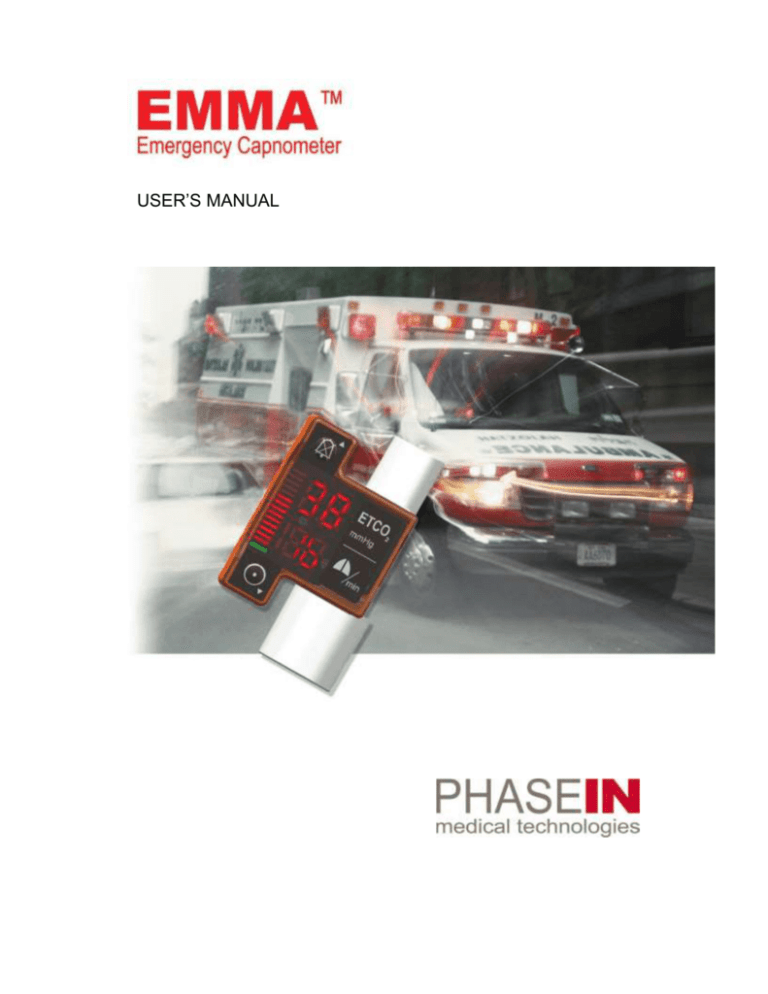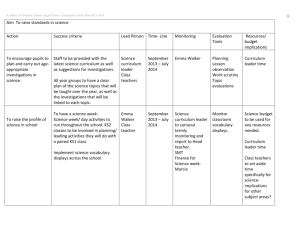
USER’S MANUAL
Important user information
All users must read this entire manual to fully
understand the safe use of EMMA Emergency
Capnometer.
Declaration of conformity
0413
Complies with 93/42/EEC Medical Device Directive.
MEDICAL EQUIPMENT
WITH RESPECT TO
ELECTRICAL SHOCK,
FIRE AND MECHANICAL
HAZARDS ONLY
IN ACCORDANCE WITH
UL 60601-1
3SJV
The obligations for PHASEIN under this guarantee
shall be limited to repair, or at PHASEIN's option,
replacement of necessary parts or assemblies and
shall not include costs of shipping.
Claims for damages during shipment must be filed
promptly with the transportation company. All
correspondence concerning the products must
specify both the name of the product and its serial
number as written on the label on the product.
Use of the equipment for other than its intended
use, or if it has been repaired by anyone except
PHASEIN or a PHASEIN authorized service
center, or altered or modified or used without
following the instructions in the user manual, will
void this warranty.
Trademarks
PHASEIN AB owns the following licensed
trademarks: PHASEIN IRMA and PHASEIN XTP
Windows and EMMA.
Safety notices
This user manual contains Warning notices and
Caution notices. These notices shall be followed.
WARNING! Warnings indicate a potential harmful
condition that can possibly lead to injury or death.
CAUTION! Cautions indicate conditions which may lead
to the damage or malfunction of the device
Liability
PHASEIN AB shall in no event be liable for any direct,
indirect, special or consequential damages including
without limitation damages for loss of business profits,
loss of income, business interruption, loss of business
information, loss of use or other related exposures,
however caused, arising from the faulty or incorrect use
of the product.
Statement
PHASEIN AB guarantees that the product delivered has
been thoroughly tested to ensure that it meets its
published specifications
Warranty
PHASEIN AB warrants the products manufactured or
distributed by them to be free from faulty materials and
workmanship for a period of 12 months from date of
original shipment to first end user except for disposable
products or products which have a stated guarantee
longer or shorter than 12 months. PHASEIN will
perform warranty service at its factory.
Patents
PHASEIN AB holds the following patents
regarding products described in this manual:
SE519766; SE519779; SE523461; SE524086.
Other patents pending.
Copyright
This document contains proprietary information
that is protected by copyright. All rights are
reserved. No part of this document may be
photocopied, reproduced or translated to another
language without prior written consent of
PHASEIN AB.
All Rights Reserved. © 2006 PHASEIN AB
Contact information
For help with this device, please contact PHASEIN
AB, Svärdvägen 15, S-18233 Danderyd, Sweden
Telephone: +46 8 544 98 150
Fax. +46 8 544 98 169
www.phasein.se,
e-mail: emmasupport@phasein.se
The information in this document is subject to
change without notice.
Article no: 0000-3804
Edition: 04
Released: February 2007
Revision history
Edition
Date
Description
04
February 2007
Update for UL/CSA
03
January 2007
Corrected dimension and WEE symbol.
02
November 2006
Added explanation of symbols, catalog numbers corrected
01
October 2006
Updated Intended Use
00
September 2006
First Edition
2 (33)
Contents
1
INTENDED USE .................................................................................................................................. 4
2
SAFETY INFORMATION .................................................................................................................... 5
2.1
2.2
2.3
3
W ARNINGS ..................................................................................................................................... 5
CAUTIONS ...................................................................................................................................... 6
SYMBOL DESCRIPTION .................................................................................................................... 7
DEVICE DESCRIPTION ...................................................................................................................... 8
3.1
EMMA EMERGENCY CAPNOMETER OVERVIEW ................................................................................. 8
3.2
PRINCIPLE OF OPERATION ............................................................................................................... 9
3.2.1
EMMA Airway Adapter ........................................................................................................ 10
4
PREPARATION FOR USE................................................................................................................ 11
4.1
4.2
4.3
4.4
5
SETTING UP .................................................................................................................................. 11
STARTING UP ................................................................................................................................ 12
SWITCHING OFF ............................................................................................................................ 12
CONNECTING THE EMMA EMERGENCY CAPNOMETER TO A BREATHING CIRCUIT .............................. 13
USER INTERFACE ........................................................................................................................... 14
5.1
OVERVIEW .................................................................................................................................... 14
5.2
CONTROLS ................................................................................................................................... 15
5.3
MONITORING ................................................................................................................................ 15
5.3.1
RESPIRATORY RATE Display ........................................................................................... 15
5.3.2
ETCO2 Display.................................................................................................................... 15
5.3.3
CO2 BAR GRAPH ............................................................................................................... 15
5.4
INDICATORS AND ALARMS.............................................................................................................. 16
5.4.1
Default Limits....................................................................................................................... 16
5.4.2
Battery Status Indicator ....................................................................................................... 16
5.4.3
Alarm Status Indicator (EMMA Monitor only) ...................................................................... 17
5.4.4
Alarm Silence (EMMA Monitor only) ................................................................................... 17
5.4.5
Display Indications .............................................................................................................. 18
5.4.6
Adjusting the ETCO2 Alarm Limits (EMMA Monitor only)................................................... 19
5.4.7
Test of Indicators and Alarms ............................................................................................. 20
6
EMMA EMERGENCY CAPNOMETER AND ACCESSORIES......................................................... 21
7
MAINTENANCE AND SERVICE ...................................................................................................... 22
7.1
7.2
7.3
7.4
7.5
7.6
7.7
8
BATTERY REPLACEMENT ............................................................................................................... 22
CLEANING .................................................................................................................................... 22
EMMA AIRWAY ADAPTER ............................................................................................................. 22
ZERO CALIBRATION....................................................................................................................... 22
RECYCLING .................................................................................................................................. 23
GAS SPAN CHECK ........................................................................................................................ 23
SERVICE AND PRODUCT RETURN REQUIREMENTS .......................................................................... 23
TECHNICAL SPECIFICATIONS ....................................................................................................... 24
8.1
8.2
8.3
8.4
GENERAL SPECIFICATIONS ............................................................................................................ 24
ELECTROMAGNETIC COMPATIBILITY (EMC) .................................................................................... 26
COMPLIANCE ................................................................................................................................ 30
CLASSIFICATIONS ......................................................................................................................... 30
3 (33)
1 Intended use
The EMMA Emergency Capnometer Monitor measures, displays and monitors carbon dioxide
concentration and respiratory rate during anesthesia, recovery and respiratory care. It may be used in
the operating suite, intensive care unit, patient room, clinic, emergency medicine and emergency
transport settings for adult and pediatric patients.
The EMMA Emergency Capnometer Analyzer measures and displays carbon dioxide concentration and
respiratory rate during anesthesia, recovery and respiratory care. It may be used in the operating suite,
intensive care unit, patient room, clinic, emergency medicine and emergency transport settings for adult
and pediatric patients.
4 (33)
2 Safety Information
2.1 Warnings
Adhere to the following warnings for safe operation of EMMA Emergency Capnometer.
WARNING! Throughout this Users Manual:
EMMA Emergency Capnometer refers to both the EMMA Monitor and EMMA Analyzer models
EMMA Monitor refers only to the EMMA Emergency Capnometer Monitor model
EMMA Analyzer refers only to the EMMA Emergency Capnometer Analyzer model
WARNING! EMMA Emergency Capnometer should only be used for the purpose and in the
manner described in this manual.
WARNING! For clinical applications EMMA Emergency Capnometer is intended for use only by
authorized and trained health care professionals.
WARNING! EMMA Emergency Capnometer must not be used with flammable anesthetic
agents.
WARNING! Use only PHASEIN manufactured EMMA Airway Adapters.
WARNING! EMMA Airway Adapters shall not be reused. Used airway adapters shall be
disposed of in accordance with local regulations for medical waste.
WARNING! The user must be aware of that the EMMA Airway Adapter will add 6 ml dead
space to the breathing circuit.
WARNING! Measurements can be affected by mobile phones and RF communications
equipment. It should be assured that the EMMA Emergency Capnometer is used in the
electromagnetic environment specified.
WARNING! EMMA Emergency Capnometer is intended only as an adjunct in patient
assessment. It must be used in conjunction with the assessment of clinical signs and
symptoms.
WARNING! Remove batteries if EMMA Emergency Capnometer is not likely to be used for a
period of time greater than 90 days.
WARNING! If EMMA Emergency Capnometer is used with a respirator or with harmful gases
such as N2O, always perform a pre-use tightness check of the patient circuit.
5 (33)
WARNING! To prevent “rain-out” and moisture from draining into the EMMA Airway Adapter,
place the adapter in the vertical position as shown in the picture below.
WARNING! Do not use EMMA Emergency Capnometer with nebulized medications as this may
affect the light transmission of the EMMA Airway Adapter windows.
WARNING! Check all alarm settings before use.
WARNING! For clinical applications do not silence the audible alarm.
WARNING! Audible alarm volume of any monitor may not be heard in some loud environments,
such as when sirens are in use and the care provider is more distant from the alarm source.
Alarm volume should be tested with the extremes of your noise environment to confirm ability or
limitations to hear an alarm in all circumstances of the environment.
2.2 Cautions
CAUTION! If the EMMA Emergency Capnometer is used in a manner other than that for which it
was intended, unpredictable behavior could result.
CAUTION! The EMMA Airway Adapters are non-sterile devices. Do not autoclave the devices
as this will damage them.
CAUTION! Never sterilize or immerse EMMA Emergency Capnometer in liquid.
CAUTION! Do not operate EMMA Emergency Capnometer at ambient temperatures less than
23°F (-5°C) or greater than 122 °F (50 °C).
CAUTION! Federal law restricts this device to sale by or on the order of a physician.
CAUTION! The use of EMMA Emergency Capnometer is restricted to one patient at a time.
6 (33)
2.3 Symbol Description
Consult User’s Manual for detailed information.
Patient Isolation – Identifies patient isolation type as BF applied part.
Symbol for Waste Electrical and Electronic Equipment (WEEE).
IPX1
According to the degree of protection against harmful ingress of water
IPX1 (drip proof equipment).
Catalog number.
7 (33)
3 Device Description
3.1 EMMA Emergency Capnometer overview
The EMMA Emergency Capnometer is a quantitative carbon dioxide mainstream monitor comprised of a
sensor body that snaps in place on top of a disposable EMMA Airway Adapter. The EMMA Emergency
Capnometer is available in two different models: EMMA Analyzer with measurement and display
functionality and EMMA Monitor with measurement, display and alarm functionality.
Feature
Battery Status Indicator (Green)
No Adapter, Check Adapter, No Breath Detected
EMMA Analyzer
EMMA Monitor
(Indicator)
(Alarm)
Alarms for High and Low ETCO2 with adjustable alarm limits
Alarm sounder
Alarm Status (Yellow)
Alarm Silence button
(EMMA Monitor only)
Alarm Status
(EMMA Monitor only)
Battery Cover
Carry strap
Alarm Silence Indicator
(EMMA Monitor only)
Battery Cover
release button
Bar Graph
Battery Status
Indicator
Power On
button
Respiratory Rate
Display
Figure 1. EMMA Monitor
ETCO2 Display
EMMA Sensor Body
EMMA Airway Adapter
Note: A figure of the EMMA Analyzer is shown in Section 5.1, Figure 9a.
8 (33)
3.2 Principle of operation
The measurement of CO2 in the breathing gas mixture is based on the fact that different gas
components absorb infrared light at specific wavelengths. A beam of invisible infrared light is directed
through the respiratory gas flow in the EMMA Airway Adapter. As the beam passes through the airway
adapter, some of the light is absorbed by the gas mixture. The amount of absorbed light is measured by
a miniaturized two channel spectrometer positioned to receive the infrared light beam.
The spectrometer incorporates a filter wheel fitted with two different optical "color" filters. The
wavelength ranges of these filters are chosen such that one filters out colors where carbon dioxide has
very strong absorption and the other filters out colors where carbon dioxide has no absorption.
The spectrometer also incorporates an infrared detector that converts the light beam to an electrical
signal. The electrical signal is converted to a digital value that is fed to a microprocessor. The ratio of the
light measured through the two filters is then used by the microprocessor to calculate the carbon dioxide
concentration in the breathing gas mixture.
Spectrometer with
optical filter wheel and
infrared detector
Infrared light source
Respiratory gas
Infrared light beam
Figure 2. Principle of operation
9 (33)
3.2.1 EMMA Airway Adapter
EMMA Emergency Capnometer snaps in place on top of the EMMA Airway Adapter. The airway adapter
may, for example, be inserted between the endotracheal tube and the resuscitation bag or between the
resuscitation bag and the patient mask. Respiratory gas measurements are, as described in the previous
section, obtained by continuously measuring the infrared light absorption through the airway adapter.
The EMMA Airway Adapter is therefore fitted with optical XTP™ windows that are transparent to light in
the wavelength ranges of interest.
XTP™ window
Figure 3. EMMA Airway Adapter with XTP™ windows
10 (33)
4 Preparation for Use
4.1 Setting up
Unpack and inspect the EMMA Emergency Capnometer for external damage.
1. Press the battery cover release button into the EMMA Emergency Capnometer body until the
battery cover pops off.
Figure 4. Releasing the battery cover
2. Open the battery compartment and insert two (2) AAA batteries. Make sure the batteries are
fitted according to the indicated polarity. After battery installation, snap battery cover back into
place.
Figure 5. Inserting batteries
11 (33)
4.2 Starting up
Attach the EMMA Airway Adapter to the EMMA Emergency Capnometer. The method to attach the
EMMA Airway Adapter to the EMMA Emergency Capnometer Sensor Body is intuitive upon visual
inspection. The EMMA Airway Adapter and EMMA Emergency Capnometer Sensor Body are designed
so that they may only be connected in the proper orientation. Physical barriers prevent attachment in an
improper orientation. The EMMA Airway Adapter and EMMA Emergency Capnometer Sensor Body will
remain attached only if placed in the proper orientation and snapped into place, using light fingerpressure force. If the EMMA Airway Adapter and EMMA Emergency Capnometer Sensor Body are not
properly fitted together they will not remain attached. It is also possible to first position the Emma Airway
Adapter in the breathing circuit and then fit the EMMA Emergency Capnometer to the Adapter. Check
that it is properly fitted and press the power on button. A start-up sequence will be initiated to check the
proper functioning of all display segments.
When the EMMA Emergency Capnometer is ready the endtidal CO 2 (ETCO2) display indicates 0, the
Respiratory Display indicates “- -“, the first segment of the bar graph and the green battery status
indicator are lit.
If the ETCO2 display shows a non-zero value, ensure that it has not been an accumulation of CO2
between the EMMA Emergency Capnometer and the EMMA Airway Adapter by removing and
reattaching the EMMA Airway Adapter. If the ETCO2 still displays a non-zero value after this procedure,
perform a Zero Calibration as described in chapter 7.4 prior to using the EMMA Emergency Capnometer
with a patient.
Figure 6. Starting up the EMMA Emergency Capnometer
4.3 Switching off
EMMA Emergency Capnometer switches off automatically according to the table below.
Condition
The EMMA Airway Adapter is removed.
A No Breath Detected condition is present.
EMMA Analyzer
automatically switches
off after:
EMMA Monitor
automatically switches
off after:
15 sec.
15 sec.
2 min
2 min after Alarm
Silence is pressed
12 (33)
4.4 Connecting the EMMA Emergency Capnometer to a breathing
circuit
The EMMA Emergency Capnometer can be connected to a patient circuit in different ways. The
following pictures illustrate the most common methods of connection.
Figure 7. EMMA Emergency Capnometer connected between an endotracheal tube and a resuscitation
bag
Figure 8. EMMA Emergency Capnometer connected to a mask
13 (33)
5 User Interface
5.1 Overview
Alarm Silence Button
(EMMA Monitor only)
Upper (▲) Limit Adjustment
for Hi/Lo ETCO2
(EMMA Monitor only)
Alarm Indicator
(EMMA Monitor only)
Alarm Silence Indicator
(EMMA Monitor only)
ETCO2 Display
ETCO2 Display
CO2 Bar Graph
CO2 Bar Graph
Respiratory Rate
Display
Respiratory Rate
Display
Battery Status
Indicator
Battery Status
Indicator
Power On Button
Power On Button
Lower (▼) Limit Adjustment
for Hi/Lo ETCO2
(EMMA Monitor only)
Figure 9a. EMMA Analyzer
Figure 9b. EMMA Monitor
14 (33)
5.2 Controls
EMMA Emergency Capnometer has one Power On push button. On the EMMA Monitor, the Power On
push button may also be used for adjusting the lower alarm limit for ETCO2 and the Alarm Silence
Button may be used for adjusting the upper alarm limit for ETCO2.
EMMA
Analyzer
EMMA
Monitor
Control
Description
Power On
Turn on the device.
Alarm Silence
Silence active alarms for 2 minutes.
Upper ETCO2 Limit Adjustment
Allow the user to change the upper high and
low ETCO2 limit.
Lower ETCO2 Limit Adjustment
Allow the user to change the lower high and
low ETCO2 limit.
5.3 Monitoring
The EMMA Emergency Capnometer has three displays: the ETCO2 display, the Respiratory Rate
display and the CO2 Bar Graph.
5.3.1 RESPIRATORY RATE Display
The RESPIRATORY RATE Display displays the Respiratory Rate (RR) in the unit breaths per minute
(0 - 199 bpm) using red numbers.
5.3.2 ETCO2 Display
The EMMA Emergency Capnometer is available in two versions displaying ETCO2 either in mmHg or
kPa, as indicated on the device labeling. The ETCO2 Display will show the ETCO2 values in kPa (0.0 9.9 kPa) or mmHg (0 - 99 mmHg) displayed as red numbers.
5.3.3 CO2 BAR GRAPH
The 14-segment red BAR GRAPH shows the current CO2 value. The table below illustrates the relation
between the bar graph and the concentration of CO2 in kPa or mmHg. The bar graph provides
qualitative information and is intended to be used as an adjunct to the two quantitative numeric displays.
The bar graph is non-linear, using smaller units of measure at the bottom and larger units of measure at
the top. The bar graph is intended to provide graphical visual communication in support of the two
primary numeric displays.
Segment 13
Segment 0
Segment
kPa
mmHg
13
12
11
10
9
8
7
6
5
4
3
2
1
0
≥ 9.0
≥ 8.0
≥ 7.0
≥ 6.0
≥ 5.0
≥ 4.0
≥ 3.0
≥ 2.0
≥ 1.5
≥ 1.0
≥ 0.75
≥ 0.5
≥ 0.25
≥ 0.0
≥ 90
≥ 80
≥ 70
≥ 60
≥ 50
≥ 40
≥ 30
≥ 20
≥ 10
≥8
≥6
≥4
≥2
≥0
Figure 10. EMMA Emergency Capnometer Monitor CO2 Bar Graph
15 (33)
5.4 Indicators and Alarms
The EMMA Analyzer is equipped with an indicator system according to the table below. The EMMA
Monitor is equipped with an Alarm Status Indicator and an audible alarm that may be silenced for a
period of 2 minutes. The EMMA Monitor Status Indicator and audible alarm operate according to the
table below.
Condition
Priority
EMMA Analyzer
EMMA Monitor
Low Battery
Advisory
Indicator
Indicator
Check Adapter
Advisory
Indicator
Alarm
No Adapter
Advisory
Indicator
Alarm
No Breath
Caution
Indicator
Alarm
ETCO2 Low
Caution
Alarm
ETCO2 High
Caution
Alarm
5.4.1 Default Limits
The default factory settings for Respiratory Rate and ETCO2 (EMMA Monitor only) are as follows:
Respiratory Rate (RR)
ETCO2 (EMMA Monitor)
Low
High
3 bpm
-
OFF
50 mmHg (7.0 kPa)
ETCO2 values are displayed after one breath and updated every breath.
RR is displayed after two breaths and updated every breath.
5.4.2 Battery Status Indicator
The Battery Status Indicator is normally lit with a steady green light. Approximately 30 minutes before
depletion, the Battery Status Indicator starts blinking.
Battery OK (> 30 min)
Battery LOW (< 30 min)
(Blinking)
16 (33)
5.4.3 Alarm Status Indicator (EMMA Monitor only)
The Alarm Status Indicator is normally not lit. When an alarm is present it is lit with a steady yellow light.
When the alarms No Breath or ETCO2 High/Low has been present for 40 seconds the Alarm Status
Indicator will start to blink.
Alarm Priority
Alarm Status Indicator
Audible Alarm
Advisory
Steady Yellow
1 tone beep and then silent for 24 seconds
Caution
Blinking Yellow
3 tone beep and then silent for 24 seconds
5.4.4 Alarm Silence (EMMA Monitor only)
If an alarm is active, pressing the Alarm Silence button will silence the
alarm for a period of 2 minutes.
The Alarm Silence status is indicated by the upper segment of the bar
graph being lit.
If a No Breath alarm is generated, the alarm can be acknowledged and
turned off by pressing the alarm silence button. The No Breath alarm
should only be turned off when a patient is not connected to the EMMA
Emergency Capnometer.
17 (33)
5.4.5 Display Indications
ETCO2 Display
-(Blinking)
Blinking Numbers
RR Display
-(Blinking)
Blinking Numbers
Bar Graph
Bar graph shows a center-out motion
Meanings
Suggested action(s)
Check Adapter
Check that the EMMA Airway
Adapter is not occluded.
Check that the EMMA Airway
Adapter is correctly attached.
No Adapter
High / Low ETCO2
(EMMA Monitor only)
Check patient
CO2 out of range
Check patient
Meanings
Suggested action(s)
No Breath
Check patient
Check Adapter
Check that the EMMA Airway
Adapter is not occluded.
No Adapter
Check that the EMMA Airway
Adapter is correctly attached.
RR out of range
Check patient
Meanings
Suggested action(s)
Check Adapter
Check that the EMMA Airway
Adapter is not occluded.
Change EMMA Airway Adapter
No Adapter
Connect Airway Adapter to EMMA
Emergency Capnometer
18 (33)
5.4.6 Adjusting the ETCO2 Alarm Limits (EMMA Monitor only)
5.4.6.1 Adjusting the High ETCO2 Alarm Limit
Press and hold the Alarm Silence button until the RR display shows “Hi” and the ETCO2 display shows
the current high ETCO2 alarm limit. Release the button. To adjust the alarm limit: press the Alarm
Silence button (▲) to increase, or the Power On button (▼) decrease the value. It is possible to switch
off the high ETCO2 alarm by adjusting the limit above 99 mmHg (9.9 kPa). EMMA Monitor will indicate
this setting by showing "- -" on the ETCO2 display during the adjustment routine.
If no button has been activated for a short period of time, EMMA Monitor will automatically resume
normal operation.
Figure 11. Adjusting the High and Low ETCO2 alarm limits
5.4.6.2 Adjusting the Low ETCO2 Alarm Limit
Press and hold the Power On button until the RR display shows “Lo” and the ETCO2 display shows the
current low ETCO2 alarm limit. Release the button. To adjust the alarm limit: press the Alarm Silence
button (▲) to increase, or the Power On button (▼) to decrease the value. It is possible to switch off the
low ETCO2 alarm by adjusting the limit down to 0. EMMA Monitor will indicate this setting by showing "- " on the ETCO2 display during the adjustment routine.
If no button has been activated for a short period of time, EMMA Monitor will automatically resume
normal operation.
5.4.6.3
Alarm limit adjustment ranges
The adjustment ranges for the ETCO2 alarm limits are as follows:
ETCO2 displayed in mmHg
ETCO2 displayed in kPa
Low
High
OFF; 1 – 89 mmHg
11 – 99 mmHg; OFF
OFF; 1 – 8.9 kPa
1.1 – 9.9 kPa; OFF
If the high ETCO2 limit is decreased close to the low ETCO2 limit, the low limit will be automatically
adjusted in order to maintain a minimum difference of 10 mmHg (1.0 kPa) between the high and low
alarm limit. Similarly, if the low ETCO2 limit is increased close to the high ETCO2 limit, the high limit will
be automatically adjusted to maintain a minimum difference of 10 mmHg (1.0 kPa) between the high and
low alarm limit.
19 (33)
5.4.7 Test of Indicators and Alarms
To test the visible status indicator and the audible alarm (EMMA Monitor only) perform the following
steps.
1. Start-up the EMMA Emergency Capnometer as described in chapter 4.2.
2. Remove the Airway Adapter
This will start the Indicator on EMMA Analyzer and the Alarm on EMMA Monitor.
When the test is completed, attach the Airway Adapter to the Sensor Body as described in chapter 4.2.
The EMMA Emergency Capnometer is ready for use.
20 (33)
6 EMMA Emergency Capnometer and Accessories
Below is a list of device models, versions and approved accessories. For an up-to date list of
accessories visit www.phasein.se
EMMA Emergency Capnometer and Accessories
Catalog number
EMMA Analyzer (kPa)
601100
EMMA Analyzer (mmHg)
601102
EMMA Monitor (kPa)
605100
EMMA Monitor (mmHg)
605102
EMMA Airway Adapter, box of 25
100620
EMMA Airway Adapter, 6 boxes of 25
100621
EMMA Airway Adapter Infant, box of 25
100660
EMMA Airway Adapter Infant, 6 boxes of 25
100661
EMMA Pouch, Box of 10
100680
EMMA Lanyard, Bag of 10
100684
21 (33)
7 Maintenance and Service
7.1 Battery Replacement
The EMMA Emergency Capnometer is equipped with a green Battery Status indicator. The Battery
Status indicator starts blinking when the remaining lifetime of the batteries is approximately 30 min.
To replace the batteries:
Open the battery compartment by pressing the release button.
Pull gently out the depleted batteries.
Insert two new AAA type batteries into the battery compartment.
NOTE: Make sure that the batteries are fitted according to the polarity marking!
When the batteries are properly in place, gently snap the battery cover back into place.
7.2 Cleaning
Remove the batteries before cleaning.
EMMA Emergency Capnometer can be cleaned using a cloth moistened with isopropyl alcohol.
CAUTION! DO NOT immerse EMMA Emergency Capnometer in any liquid.
E 7.3
EMMA Airway Adapter
The EMMA Airway Adapters are intended for single patient use. They are disposable and shall not
be re-used.
Treat used EMMA Airway Adapters in accordance with hospital protocol for disposable items.
7.4 Zero Calibration
To zero calibrate EMMA Emergency Capnometer proceed as follows:
Make sure that the EMMA Airway Adapter is properly attached.
Start EMMA Emergency Capnometer by pressing the ON button.
EMMA Analyzer: Press and hold down the ON button until the ETCO2 display shows “10” and
the RR display shows “C0”. Keep the button depressed while the ETCO2 Display starts
"counting down" i.e. displaying "9" - "8" - "7" etc and until "0" is displayed.
EMMA Monitor: Press and hold down simultaneously the ON and Alarm Silence button until the
ETCO2 display shows “10” and the RR displays “C0”. Keep both buttons depressed while the
ETCO2 Display starts "counting down" i.e. displaying "9" - "8" - "7" etc and until "0" is displayed.
Once “0” is displayed on the ETCO2 display, zero calibration of the EMMA Emergency
Capnometer is completed.
Gas readings should be verified with a reference instrument at regular intervals. A zero reference
calibration of the IR measurement should be performed whenever an offset in gas readings is
discovered.
22 (33)
7.5 Recycling
The EMMA Emergency Capnometer and the EMMA Airway Adapter shall be disposed in accordance to
local regulations for recyclable products. Dispose the old batteries according to local regulations.
7.6 Gas Span Check
Gas readings should be verified at regular intervals with a reference instrument.
7.7 Service and Product Return Requirements
Please contact PHASEIN about how to return a product for service using the contact details under
Important User Information on the front inside cover of this manual. Products under warranty will be
exchanged free of charge except for the cost of inbound freight.
23 (33)
8
Technical Specifications
8.1 General Specifications
General
EMMA Emergency Capnometer
Description
Compact, battery powered, quantitative capnometer for mainstream
CO2 monitoring of adults and pediatrics.
Measurements
Non-dispersive IR absorption
Models
EMMA Analyzer (non-alarm)
EMMA Monitor (full-alarm)
Versions
CO2 displayed in kPa or mmHg
Warm up
In operation and full accuracy within 5 sec.
Calibration
No routine calibration required
Certifications
CE marked per 93/42/EEC, FDA 510(k) and UL/CSA 60601-1
Dimensions
52 x 39 x 39 mm (2.1 x 1.5 x 1.5 inches)
Weight
Approximately 60 g (2.1 oz) with batteries
Shock absorption
Withstands repeated 1 m drops
Environment
Operating conditions
Temperature: -5 - +50°C (23 to 122°F)
Humidity: 10 - 95% RH (non-condensing)
Atmospheric pressure: 70 - 120 kPa (1)
Storage conditions
Temperature: -30 - +70°C (-22 to 158°F)
Humidity: 5 - 100% RH (condensing)
Atmospheric pressure: 50 - 120 kPa
Displays
ETCO2
LED Numeric Display
Respiratory rate
LED Numeric Display
CO2 Bar Graph
14 segment LED bar graph
Controls
Power
ON key
Alarm Silence
2 min. alarm silence key (EMMA Monitor only)
ETCO2
Up/Down key for setting alarm limits (EMMA Monitor only)
CO2
Range
0 - 99 mmHg (0 - 9.9 kPa) (2)
Accuracy
0-40 mmHg ± 2 mmHg, 41-99 mmHg 6% of reading, during standard
conditions.(3)
Rise time
≤ 60 ms
Total system response time
< 0.5 sec.
24 (33)
General
EMMA Emergency Capnometer
Respiratory Rate (RR)
Respiratory rate
3 - 150 breaths/min
Accuracy
± 1 bpm
Breath detect
Adaptive threshold, minimum 1 kPa CO2 change
EMMA Airway Adapters
Adult
6 ml dead space
Indicators and Alarms
EMMA Analyzer
Indicators for: No Adapter, Check Adapter, No Breath Detected, Low
Battery
EMMA Monitor
Alarms for: No Adapter, Check Adapter, No Breath Detected, Low
Battery, Low ETCO2, High ETCO2
Sound Intensity Level
≥ 80 dBA (EMMA Monitor only)
Power requirements
Batteries
Two (2) AAA Cell Alkaline Batteries (2 x 1.5VDC) (IEC Type LR03)
Battery life time
8 hours of normal use
Power status
LED indicator
Notes:
(1)
EMMA Emergency Capnometer displays CO2 in partial pressure units (kPa or mmHg) and thus does
not require barometric pressure compensation.
(2)
Gas reading showing actual partial pressure at current humidity level.
(3)
To include quantitative effect on gas reading from variations in environment conditions and presence
of N2O, anesthetic agents, Ethanol, Isopropyl alcohol, He, Acetone and Methane, then the CO2
accuracy range should be increased to ± 4 mmHg or 10% of reading whichever is the greater.
25 (33)
8.2 Electromagnetic Compatibility (EMC)
Guidance and PHASEIN’s declaration – electromagnetic emissions –
for EMMA Emergency Capnometer
The EMMA Emergency Capnometer is intended for use in the electromagnetic environment specified
below. The customer or the user of the EMMA Emergency Capnometer should assure that it is used in
such an environment.
Emissions test
RF emissions
CISPR 11
RF emissions
CISPR 11
Compliance
Group 1
Class B
Electromagnetic environment – guidance
The EMMA Emergency Capnometer uses RF energy only
for its internal function. Therefore, its RF emissions are
very low and are not likely to cause any interference in
nearby electronic equipment.
The EMMA Emergency Capnometer is suitable for use in
all establishments including domestic establishments and
those directly connected to the public low-voltage power
supply network that supplies buildings used for domestic
purposes.
Harmonic emissions
IEC 61000-3-2
Not applicable
Not applicable
Voltage fluctuations/
flicker emissions
IEC 61000-3-3
Not applicable
Not applicable
26 (33)
Guidance and PHASEIN’s declaration – electromagnetic immunity –
for EMMA Emergency Capnometer
The EMMA Emergency Capnometer is intended for use in the electromagnetic environment specified
below. The customer or the user of the EMMA Emergency Capnometer should assure that it is used in
such an environment.
Immunity test
IEC 60601
test level
Compliance
level
Electromagnetic environment –
guidance
Electrostatic
discharge (ESD)
IEC 61000-4-2
6kV contact
8 kV air
6 kV contact
8 kV air
Floors should be wood, concrete or
ceramic tile. If floors are covered with
synthetic material, the relative humidity
should be at least 30 %.
Electrical fast
transient/burst
IEC 61000-4-4
2 kV for
power supply
lines
1 kV for
input/output
lines
Not applicable
Not applicable
Surge
IEC 61000-4-5
1 kV
differential
mode
Not applicable
Not applicable
Voltage dips, short
interruptions and voltage
variations on power supply
input lines
IEC 61000-4-11
Not applicable
Not applicable
Not applicable
Power frequency
(50/60 Hz)
magnetic field
IEC 61000-4-8
3 A/m
30 A/m
Power frequency magnetic fields
should be at levels characteristic of a
typical location in a typical commercial
or hospital environment.
Note: UT is the a.c. mains voltage prior to application of the test level.
27 (33)
Guidance and PHASEIN’s declaration – electromagnetic immunity –
for EMMA Emergency Capnometer
The EMMA Emergency Capnometer is intended for use in the electromagnetic environment specified
below. The customer or the user of the EMMA Emergency Capnometer should assure that it is used in
such an environment.
Immunity test
IEC 60601 test
level
Compliance
level
Electromagnetic environment – guidance
Portable and mobile RF communications
equipment should be used no closer to any
part of the EMMA Emergency Capnometer
than the recommended separation distance
calculated from the equation applicable to the
frequency of the transmitter.
Recommended separation distance
Conducted RF
IEC 61000-4-6
3V
150 kHz to 80
MHz
3V
d = 1.17P
d = 0.18P 80 MHz to 800 MHz
Radiated RF
IEC 61000-4-3
3 V/m
80 MHz to 2.5
GHz
20 V/m
d = 0.35P 800 MHz to 2.5 GHz
where P is the maximum output power rating of
the transmitter in watts (W) according to the
transmitter manufacturer and d is the
recommended separation distance in meters
(m).
Field strengths from fixed RF transmitters, as
determined by an electromagnetic site survey,
a should be less than the compliance level in
each frequency range.b Interference may occur
in the vicinity of equipment marked with the
following symbol:
Note 1: At 80 MHz and 800 MHz, the higher frequency range applies.
Note 2: These guidelines may not apply in all situations. Electromagnetic propagation is affected by
absorption and reflection from structures, objects and people.
a
Field strengths from fixed transmitters, such as base stations for radio (cellular/cordless) telephones
and land mobile radios, amateur radio, AM and FM radio broadcast and TV broadcast cannot be
predicted theoretically with accuracy. To assess the electromagnetic environment due to fixed RF
transmitters, an electromagnetic site survey should be considered. If the measured field strength in the
location in which the EMMA Emergency Capnometer is used exceeds the applicable RF compliance
level above, the EMMA Emergency Capnometer should be observed to verify normal operation. If
abnormal performance is observed, additional measures may be necessary, such as reorienting or
relocating the EMMA Emergency Capnometer.
b
Over the frequency range 150 kHz to 80 MHz, field strengths should be less than 20 V/m.
28 (33)
Recommended separation distances between portable and mobile RF communications
equipment and the EMMA Emergency Capnometer
The EMMA Emergency Capnometer is intended for use in an electromagnetic environment in which
radiated RF disturbances are controlled. The customer or the user of the EMMA Emergency
Capnometer can help prevent electromagnetic interference by maintaining a minimum distance between
portable and mobile RF communications equipment (transmitters) and the EMMA Emergency
Capnometer as recommended below, according to the maximum output power of the communications
equipment.
Rated maximum
output power of
transmitter
W
Separation distance according to frequency of transmitter
m
150 kHz to 80 MHz
d = 1.17P
80 MHz to 800 MHz
d = 0.18P
800 MHz to 2.5 GHz
d = 0.35P
0.01
0.12
0.018
0.035
0.1
0.37
0.057
0.11
1
1.2
0.18
0.35
10
3.7
0.57
1.1
100
12
1.8
3.5
For transmitters rated at a maximum output power not listed above, the recommended separation
distance d in meters (m) can be estimated using the equation applicable to the frequency of the
transmitter, where P is the maximum output power rating of the transmitter in watts (W) according to the
transmitter manufacturer.
Note 1: At 80 MHz and 800 MHz, the separation distance for the higher frequency range applies.
Note 2: These guidelines may not apply in all situations. Electromagnetic propagation is affected by
absorption and reflection from structures, objects and people.
Warning: Measurements can be affected by mobile phones and RF communications equipment. It
should be assured that the EMMA Emergency Capnometer is used in the electromagnetic environment
specified.
29 (33)
8.3 Compliance
MDD 93/42/EEC
ISO 21647:2004
EN/IEC 60601-1:1990, Amendment1 (1991), Amendment2 (1995)
EN/IEC 60601-1-2:2001
ISO 5356-1
EN/IEC 60601-1-8:2003
prEN 1789:2004
8.4 Classifications
According to the type of protection against electric shock
INTERNALLY POWERED EQUIPMENT (Battery power)
According to the degree of protection against electric shock
TYPE BF APPLIED PART
According to the degree of protection against harmful ingress of water
IPX1 (drip proof EQUIPMENT)
According to the mode of operation
CONTINUOUS OPERATION
According to the degree of safety of application in the presence of a FLAMMABLE ANESTHETIC
MIXTURE WITH AIR, OR WITH OXYGEN OR NITROUS OXIDE
EQUIPMENT not suitable for use in the presence of FLAMMABLE ANESTHETIC
MIXTURE WITH AIR; OR WITH OXYGEN OR NITROUS OXIDE
According to the susceptibility to vibrations
MEDICAL DEVICE FOR USE IN ROAD AMBULANCES
(ASD 5 - 20 Hz,: 00.5 g2/Hz, ASD 20 - 200 Hz: 0.05 g2/Hz -3 dB/octave)
According to sterility
No part of the EMMA Emergency Capnometer is sterile.
30 (33)
Notes:
31 (33)
Notes:
32 (33)
Alarm
Indicator
(EMMA
Monitor
only)
PHASEIN AB
Svärdvägen 15
182 33 Danderyd
Sweden
www.phasein.se
All Rights Reserved. © 2006 PHASEIN AB
The information in this document is subject to change without notice.
33 (33)








